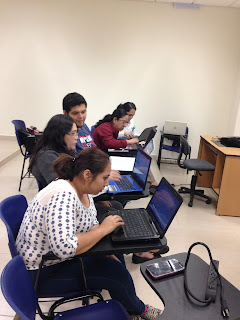These are some pics of we've seen:
Fish Acclimatization:
Fish culture:
Zebrafish eggs (and some larvae):
Water quality parameters of the fish tank:
Some fish eggs and larvae culture (maintenance with algae):
Ecotox: Thesis and Research
PhD Thesis Research about Aquatic Ecotoxicology in a mexican river. PhD in Ecology (PNPC-CONACYT). 2013-2016. Instituto de Ecología Aplicada (UAT), México
Wednesday, April 25, 2018
What we do in the Bioassays class with microalgae
Here are some pics of my proudly teaching labour:
Microalgae in solid medium:
This is a collected microalgae by my students:
Microalgae in solid medium:
This is a collected microalgae by my students:
Teaching Bioassays
These are my BIOASSAYS students !
They've learned about microalgae and fish culture and some bioassays.
Mainly of we've seen in microalgae is sampling, medium preparation (with F/2), identification, isolation (with serial dilution and solid agar medium), growth (through Neubauer chamber and spectrophotometer) and calculate IC50 (through non lineal regression with a logistic 4P equation in Prism).
In fish we've seen is water preparation, water quality, acclimatization, sex identification, breeding (with stones traps), egg collection, egg identification, viability and hatching of eggs, larvae growth, and behavior through anesthetic effects.
Teaching is great, but more if you are teaching what you like.
:)
These are my other students of Inferential Biostatistics:
They've learned about microalgae and fish culture and some bioassays.
Mainly of we've seen in microalgae is sampling, medium preparation (with F/2), identification, isolation (with serial dilution and solid agar medium), growth (through Neubauer chamber and spectrophotometer) and calculate IC50 (through non lineal regression with a logistic 4P equation in Prism).
In fish we've seen is water preparation, water quality, acclimatization, sex identification, breeding (with stones traps), egg collection, egg identification, viability and hatching of eggs, larvae growth, and behavior through anesthetic effects.
Teaching is great, but more if you are teaching what you like.
:)
These are my other students of Inferential Biostatistics:
Tuesday, April 24, 2018
Natural Species collected
I want to show you some natural species collected, planned to use for ecotoxicological assays:
"Gastropodes"
How do you see?
Please, make some comments, thank you!
"Gastropodes"
How do you see?
Please, make some comments, thank you!
Ecotoxicology Services in Mexico
Hello guys,
Self professional page of Ecotoxicology Services in Mexico, maybe you can find some useful information:
https://ciabso.wordpress.com/
Thank you!
Self professional page of Ecotoxicology Services in Mexico, maybe you can find some useful information:
https://ciabso.wordpress.com/
Thank you!
Tuesday, December 6, 2016
In Mexico: They will identify hydrocarbon spills through analysis of satellite images
Researchers from CENIT2 (Nayarita Center for Innovation and Technology Transfer) of the Autonomous University of Nayarit (UAN) will analyze the rivers of Nayarit, using software that uses satellite images, to identify possible spills of hydrocarbons in the Gulf of Mexico. The software called ARTMOS (Automated Radiative Transfer Models Operator) generates algorithms from biophysical parameters and identifies the differences between a spot and oceanic water. It is a free tool and is available in http://ipl.uv.es/artmo/
Link: CONACYTPRENSA
Friday, August 19, 2016
Tips for choosing a laboratory or mentor
During the student stage, the most critical thing is to make an informed decision when choosing the research laboratory to develop your career, so you can enjoy doing science. According to a publication made by HOT, you must cover the following aspects:
Know yourself: by asking yourself self-reflective questions, the research environment should go with your lifestyle and personality. Select a tutor who is a good scientist and a good mentor: if your main researcher (IP) is not a good scientist or does not know how to become one, it will be more difficult for you to be one of them! The way your IP addresses challenges and opportunities will be the way in which you will manage your independent laboratory. Your tutor must have good research qualities and as a mentor! This to guide you as a person, share your experience and support you throughout your long-term development. Select a research environment that is right for you. Where you feel comfortable with your research group and cover your needs. Select a research project that makes you interesting. That motivates you and allows you to develop new skills. Try to be a Pioneer in new areas! Track for current positions. In case you are interested in being part of the academy. Be alert for possible warnings. For example, excessive overlap between projects, depressed people, members who do not respect the IP, etc.
Know yourself: by asking yourself self-reflective questions, the research environment should go with your lifestyle and personality. Select a tutor who is a good scientist and a good mentor: if your main researcher (IP) is not a good scientist or does not know how to become one, it will be more difficult for you to be one of them! The way your IP addresses challenges and opportunities will be the way in which you will manage your independent laboratory. Your tutor must have good research qualities and as a mentor! This to guide you as a person, share your experience and support you throughout your long-term development. Select a research environment that is right for you. Where you feel comfortable with your research group and cover your needs. Select a research project that makes you interesting. That motivates you and allows you to develop new skills. Try to be a Pioneer in new areas! Track for current positions. In case you are interested in being part of the academy. Be alert for possible warnings. For example, excessive overlap between projects, depressed people, members who do not respect the IP, etc.
- Reference: HOT newsletter june- jul 2016 (page 10).
Subscribe to:
Comments (Atom)
























